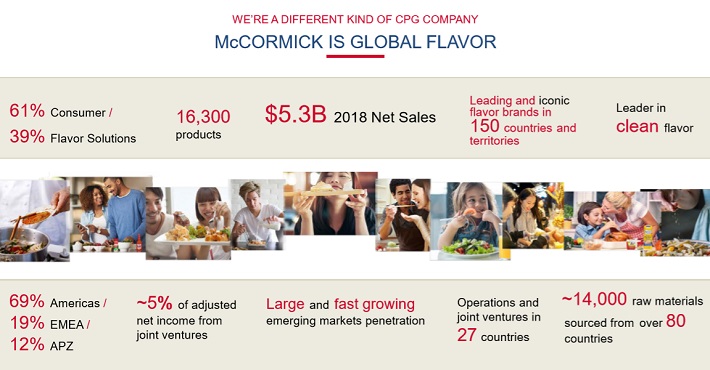Updated on December 27th, 2019 by Bob Ciura
In order to become a Dividend Aristocrat, a company must have a strong brand and a dominant industry position.
The Dividend Aristocrats are a group of 57 companies in the S&P 500 Index, with 25+ consecutive years of dividend increases.
You can download an Excel spreadsheet with the full list of Dividend Aristocrats by using the link below:
A perfect example of a Dividend Aristocrat with an industry-leading brand, is consumer products company McCormick & Company (MKC). McCormick has paid dividends each year since 1925, and has increased its dividend for 34 years in a row.
Its dividend growth streak is due to its high-quality business. McCormick is the global leader in food spices, seasonings, and flavors. The company controls nearly 20% of this highly fragmented industry.
This has fueled McCormick’s dividend growth for many years. The stock has a 1.5% dividend yield, which is slightly below the average yield of the S&P 500. However, its business model and growth prospects are anything but average. McCormick is an excellent choice for dividend growth. The company’s dividend is also very safe, which is a topic we explore in the following video:
Business Overview
McCormick was formed in 1889, when founder Willoughby M. McCormick started making flavors and extracts in his cellar, which he then sold door-to-door. At first, the business grew at a gradual pace. In 1896, McCormick entered spices by issuing its first McCormick’s Cookbook. Over time, the company has steadily built itself into the leading spices and seasonings company in the world.
McCormick & Company produces, markets and distributes seasoning mixes, spices, condiments and other products to customers in the food industry. Major brands include McCormick, Lawrys, Stubb’s, Club House, Ducros, Schwartz, Kamis, Kohinoor, Zatarains, Thai Kitchen, and Simply Asia.
Source: Investor Presentation
It has a market capitalization is $22 billion, with annual revenues of $5.3 billion in 2018. McCormick reported third quarter earnings results on 10/1/2019. The company’s adjusted earnings-per-share of $1.46 was a 14% improvement from the previous year and $0.17 above estimates. Revenue increased 1% from the same quarter last year, while revenue excluding current impacts rose by 2% for the quarter.
The Consumer segment had sales growth of 2.8%. Volume/product mix added 4% to growth, with currency reducing results by 1.2%. The Americas region had 3.5% growth due to the strength of across the portfolio of products. Sales for the Flavor Solutions segment were down 2% last quarter. Price inched up 0.2%, but this was more than offset by a 0.6% decline in volumes and a currency headwind of 1.6%. Each region for this segment saw declining sales, but this was most pronounced in the Asia/Pacific region. This region was down 3.9% due to promotional activities and the exit of a low-margin business.
The business environment for McCormick is very strong. It is benefiting from changing trends. Consumers are cooking more at home, due in part to falling grocery prices. To do this, consumers are using more spices, seasonings, and flavorings. This has created a favorable fundamental backdrop for McCormick, and as the industry leader, it has taken full advantage. The company maintains positive growth potential in the years ahead.
Growth Prospects
Going forward, there is plenty of room for continued growth for McCormick, due to growth in the emerging markets, and also acquisitions. First, international growth is a strong catalyst for McCormick, particularly in emerging markets like China.
McCormick’s sales in the Asia/Pacific region, particularly in China, have improved dramatically in recent years thanks to its popular brands like Daqiao and others. This growth is evident primarily in the consumer segment. The strongest region for the company last quarter was the Asia/Pacific region. A 4% currency headwind only partially offset a 11.6% improvement in volume/mix and 3.3% increase in price.
Higher demand for herbs and spices, flavor sauces and chicken bouillon were the primary reasons for this growth. Increased prices also contributed to sales growth in the region. Economic growth in the emerging markets is generally higher than in developed nations.
Separately, acquisitions are a major part of McCormick’s growth strategy. In 2018, McCormick acquired Frank’s RedHot and French’s as part of a $4.2 billion purchase of RB Foods, the food division of consumer products giant Reckitt Benckiser (RGBLY). This was the largest deal in McCormick’s history, and is already a driver of growth for the company. RB Foods added 8% to the company’s sales growth in 2018, and should continue to contribute to sales growth in the coming years.
McCormick has utilized its leadership position in industry to quickly expand these top brands globally.
Source: Investor Presentation
For example, Frank’s RedHot is the leading hot sauce brand in the U.S., with double the market share of the next-closest competing brand. Meanwhile, French’s has four times the retail market share as the next closest mustard brand. The common theme within McCormick’s M&A strategy is that it seeks out top brands that lead their respective categories, that can be easily scaled up.
This year will be another year of strong growth for the company. Following third quarter results, management updated company guidance for the full fiscal year. It expects to earn between $5.30 – $5.35 for the year, up from a midpoint of $5.27 per share. The midpoint of the updated guidance represents a 7.2% increase from results for 2018. Reported sales are expected to grow between 1% to 2%, with currency reducing results by 1% to 2%.
McCormick has increased earnings-per-share every year for the past ten years. Over this time frame, earnings have increased at an average of 7.1% per year. The addition of RB Foods in 2017 has worked in the company’s favor over the last year. In fact, we feel that this acquisition will help to increase earnings growth going forward, as we now project that McCormick can grow earnings at a rate of 8% per year.
Competitive Advantages & Recession Performance
The two most important competitive advantage for McCormick are its brand strength and global scale. McCormick is the top brand in the global spices and seasonings industry, which is expected to grow for the next five years. And, McCormick has market share of 20%, which makes it nearly four times the size of its next-largest competitor.
As a result, this gives McCormick leverage over retailers, and pricing power. These qualities help the company generate consistent profits each year, even when the economy enters recession.
McCormick managed to grow earnings-per-share each year during the last recession. Earnings-per-share during the Great Recession are below:
- 2007 earnings-per-share of $1.92
- 2008 earnings-per-share of $2.14 (11% increase)
- 2009 earnings-per-share of $2.34 (9.3% increase)
- 2010 earnings-per-share of $2.65 (13% increase)
As you can see, McCormick & Company grew earnings-per-share every year through the Great Recession. Not only that, the company averaged double-digit annual growth each year, which was highly impressive and a very rare accomplishment, even for a Dividend Aristocrat.
Valuation & Expected Returns
At the midpoint of full-year guidance, McCormick expects adjusted earnings-per-share of $5.32 this year. As a result, the stock trades for at a price-to-earnings ratio of 32.4. This is slightly above its 10-year average price-to-earnings ratio of ~21.
McCormick’s valuation multiple has expanded considerably in recent years, as the company has turned in strong earnings growth. Due to strength of RB Foods and the company’s ability to capture market share, we have a 2025 price-to-earnings target of 21. Still, the stock appears to be significantly overvalued. If the stock reverted to our target P/E by 2024, then valuation would be a 8.3% headwind to annual returns over this time period.
Fortunately, shareholder returns will be derived from expected earnings growth and dividends. McCormick has increased its earnings-per-share by 7% per year, over the past 10 years. It is worth noting that the past decade includes the Great Recession.
If the economy stays out of recession, the company should easily manage at least 8% earnings growth going forward. The company’s strong brand and multiple catalysts for future growth should add up to higher growth as well.
A potential breakdown of expected returns is below:
- 8% earnings-per-share growth
- 1.5% dividend yield
- 8.3% valuation reversion
In all, we feel investors can expect total annual returns of 1.2% through 2025. The high valuation is putting a lid on our expected total return. Since we have such a low expected rate of return for McCormick, we currently rate the stock a sell.
That said, McCormick is a high-growth dividend stock. The company has increased its dividend by 9% per year over the past five years. It recently increased its quarterly dividend by 8.8%.
McCormick has a healthy dividend payout ratio, of 47% based on expected 2019 adjusted earnings-per-share. This means McCormick should continue its annual dividend increases for many years to come.
Final Thoughts
McCormick dominates the spices and seasonings category. Its strong brands provide the company with high profit margins and growth opportunities, both in the U.S. and the international markets.
Income investors may be turned off by McCormick’s 1.5% dividend yield. However, McCormick has a very strong dividend growth history. It should be able to lift the dividend each year, at a high single digit annual rate.
That being said, the stock is not a buy right now. It has a premium valuation multiple, and while it could be argued that a high-quality company such as McCormick deserves a higher stock valuation, we have a low expected rate of return. Still, the very high price-to-earnings ratio makes the stock a sell, as we believe investors should take profits in the stock and reinvest the proceeds in a stock with a higher expected rate of return.
That said, we would be buyers of McCormick on a meaningful pullback in the share price, which would result in a lower valuation and a higher dividend yield.







